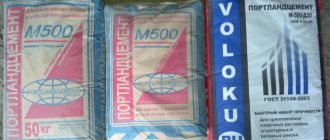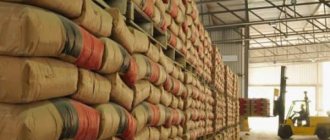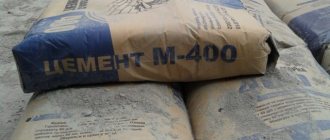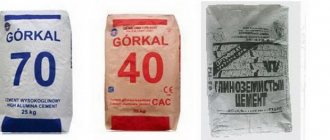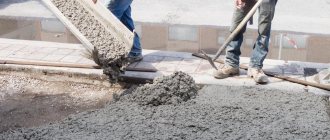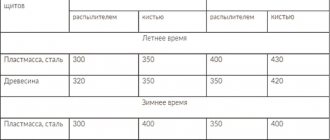Concrete products are characterized by high resistance to mechanical loads and aggressive conditions over a long period of time. The best composite for the construction of external, underground and underwater structures is considered to be sulfate-resistant cement. The production of this material is regulated by the current GOST 22266 of 2013.
Preparation
This type of cement is obtained from crushed clinker, which is mixed with calcium and silicate aluminate. Particular attention in this matter is paid to dosage. Aluminate, for example, should not be contained in a volume of more than 5%; as for silicate, its volume is 50%. This ratio is not accidental. There are many sulfates in nature that, when in contact with tricalcium hydroaluminate, cause sulfate corrosion. The feedstock contains a minimal amount of iron.
Application
Sulfate-resistant cement is used for concreting underground and underwater massifs. It has unique properties, therefore it is resistant to external chemical and natural factors. This cement is immune to aggressive chemicals, which are indispensable in construction.
In conditions where conventional building materials are not capable of creating a strong structure, the described cement helps. It has a low degree of hardening, which distinguishes it from ordinary cement. Density is the main factor that determines the durability of the work performed.
State standards. Varieties. Compound
Sulfate-resistant Portland cement can have different compositions and is:
- slag Portland cement;
- with mineral supplements;
- pozzolanic Portland cement.
This building material is resistant to factors of chemical and natural origin. The composition contains components that make it possible to obtain a building that is not subject to destruction due to variable temperature and moisture.
When choosing sulfate-resistant Portland cement, you need to familiarize yourself with the composition, because a certain soil requires a certain material. The one described is created on the basis of clinker, silicate and calcium aluminate. It is widely used in the construction of hydraulic structures. Such cements are manufactured in accordance with GOST 22266-2013.
Preface
1 DEVELOPED by the State Institute of Cement Industry (NIIcement) of the Russian Federation
INTRODUCED by the Ministry of Construction of Russia
2 ADOPTED by the Interstate Scientific and Technical Commission for Standardization and Technical Regulation in Construction (INTKS) on November 17, 1994.
Voted for acceptance
| State name | Name of the state construction management body |
| Republic of Armenia | State Architecture of the Republic of Armenia |
| Republic of Belarus | Gosstroy of the Republic of Belarus |
| The Republic of Kazakhstan | Ministry of Construction of the Republic of Kazakhstan |
| Republic of Kyrgyzstan | Gosstroy of the Kyrgyz Republic |
| Russian Federation | Ministry of Construction of Russia |
| Republic of Tajikistan | State Construction Committee of the Republic of Tajikistan |
| The Republic of Uzbekistan | State Committee for Architecture and Construction of the Republic of Uzbekistan |
3 ENTERED INTO EFFECT on January 1, 1996 as a state standard of the Russian Federation by Resolution of the Ministry of Construction of Russia dated May 3, 1995 No. 18-40
4 INSTEAD GOST 22266-76
Characteristics of SSPTs 400-D0
Sulfate-resistant cement SSPTs 400 DO is a type of Portland cement. It is resistant to sulfate waters. Even ordinary groundwater contains large amounts of sulfates. They contribute to the destruction of concrete. To protect concrete structures from sulfate aggression, SSPC is used.
Cement is widely used in the construction of foundations and bridge supports at high groundwater levels. Along with certain advantages, this type of Portland cement has all the main characteristics of PC 400-D0. The grade of compressive strength is mentioned in the labeling and is 400 on the 28th day. Hardening speed: normal hardening. This material is manufactured in accordance with GOST 22266-94. Compressive strength on the third day is not standardized. At the age of 28 days, the compressive strength is 39.2 MPa. The bending strength on the 28th day is 5.4 MPa. Setting begins at the 45th minute, not earlier. There are no mineral additives in this cement.
How to make?
The preparation of sulfate-resistant concrete is not much different from the production of conventional concrete mortar. To make the mixture you will need sand and cement in proportions of one to three. Before adding mineral additives, it is important to check their effect on the building material. All technological components must be proven by testing.
The test is carried out on the setting of the solution, for which, during the boiling process, uniform changes in the amount of the mixture are ensured and its setting is checked, which occurs no earlier than forty-five minutes from the hardening process.
Also, when making concrete, gypsum stone, water, clinker or other materials containing calcium sulfate are used. Not everyone can afford the use of such cement, so it is not used as often as ordinary concrete, but its characteristics are incomparable with a simple concrete mixture.
Return to contents
Additives for cement
The described product is obtained by grinding clinker of a standardized mineralogical composition and gypsum. On sale you can find Portland cement with mineral additives in the form of electrothermophosphate slag and granulated blast furnace slag. These substances are added in a volume of 20% of the total mass. Active additives can be contained in the range from 5 to 10%. Such cement, the GOST of which was mentioned above, has a relatively low alumina modulus, as well as a saturation coefficient.
For production, clinker is used, which contains no more than 5% C3A and no more than 50% C3S. The total sum of C3A and C4AF should not exceed 22%. Cement additives are C3A and C3S. In this regard, the material has a reduced heat release, since the mentioned substances are contained in moderate quantities. On sale you can find a sulfate-resistant variety marked 400. If there are mineral additives, then the grade can be 500. The compressive strength on the 28th day is 40 MPa, but if there are mineral additives, then this figure rises to 50 MPa.
This material is used to create concrete structures and hydraulic structures exposed to sulfate-containing waters.
Properties
Sulfate-resistant concrete contains clinker, gypsum and tricalcium aluminate, and mineral additives can be added. Tricalcium aluminate is added to the concrete mixture in an amount of no more than five percent of the total mass; excess material provokes sulfate corrosion. A distinctive property when working with sulfate-resistant concrete is the rapid hardening of the cement-sand mixture, which negatively affects the strength of the finished product.
Return to contents
Explanation of markings
Construction cements have their own markings, approved and described in SNILS and GOSTs. The material can also be manufactured according to other regulatory documents. If you saw PC among the first letter designations, then this is Portland cement. Portland slag cement is abbreviated as ShPTs. You can understand that this is sulfate-resistant Portland cement by the letters SPTs or SSPTs.
When mineral additives are present in the material, the letter D is added to the abbreviation, then the marking looks like this: SPCD. Sulfate-resistant Portland slag cement is designated SSSHPTs. If you have pozzolanic and tensile cements in front of you, you will see the following letters: PPC and NC, respectively. White Portland cement and waterproof expansive cement are designated by the letters PCB and VRC.
Cement marking and interpretation is important for the consumer. This way he will be able to purchase the goods he needs. After the first letters there will be numbers indicated, which in the markings look like this: PC-500. This indicates that this is grade 500 cement. The markings may be followed by other numbers and letters. For example, if cement has a maximum content of additives, then you will see: D0, D5, D20. This corresponds to a percentage of 0.5 or 20%.
Rapid-hardening cement is designated by the letter B. Plasticizing cement is PL, hydrophobized cement is GF. Material with a standardized clinker composition - N. At the end of the marking a regulatory document is indicated. These may be technical specifications or state standards on the basis of which the material is manufactured.
2 Normative references
This standard uses normative references to the following interstate standards:
GOST 3476-74 Granulated blast furnace and electrothermophosphorus slags for cement production
GOST 4013-82 Gypsum and gypsum anhydrite stone for the production of binding materials. Specifications
GOST 5382-91 Cements and materials for cement production. Chemical analysis methods
GOST 6613-86 Woven wire mesh with square cells. Specifications
GOST 30108-94 Construction materials and products. Determination of specific effective activity of natural radionuclides
GOST 30515-2013 Cements. General technical conditions
GOST 30744-2001 Cements. Test methods using polyfraction sand
GOST 31108-2003 General construction cements. Specifications
Note - When using this standard, it is advisable to check the validity of the reference standards in the public information system - on the official website of the Federal Agency for Technical Regulation and Metrology on the Internet or using the annual information index "National Standards", which was published as of January 1 of the current year, and on issues of the monthly information index “National Standards” for the current year. If the reference standard is replaced (changed), then when using this standard you should be guided by the replacing (changed) standard. If the reference standard is canceled without replacement, then the provision in which a reference is made to it is applied in the part that does not affect this reference.
Plasticized and hydrophobic Portland cement
Plasticized Portland cement differs from ordinary cement in its ability to impart increased mobility to concrete and mortars. This effect can be achieved by introducing clinker in a volume of 0.25%. Sulfide-yeast mash acts as a hydrophobizing additive. It increases the plasticity of cement paste. Concrete structures with the addition of such cement receive a plasticizing effect, which makes it possible to reduce the water-cement ratio and increase the density and water resistance of the structure.
Hydrophobic Portland cement is produced by adding 0.1% clinker, acidol, and synthetic fatty acids. The composition may also contain hydrophobic additives. These substances can reduce hygroscopicity, so cement differs from ordinary cement in that it does not deteriorate when stored in humid conditions. It does not clump and remains active. In this regard, sulfate-resistant hydrophobic Portland cement is recommended for use in areas with high humidity. The main substance there is stored in hardened materials and increases their water resistance, increasing resistance to external aggressive conditions.
Manufacturers of sulfate-resistant cement in Russia
List of Russian cement plants producing sulfate-resistant Portland cement and Portland slag cement (as of July 2022):
- Podolsky;
- Volsky - JSC HeidelbergCement Volga, located in the Saratov region;
- Mordovcement is part of the EUROCEMENT group holding;
- Krasnoyarsk;
- Magnitogorsk;
- Novotroitsky - Orenburg region;
- Serebryakovsky - Volgograd region;
- Teploozersky - Vladivostok;
- Timlyuysky - Buryatia;
- Yakut.
It is necessary to clarify whether this type of cement is produced at the plant closest to a specific construction site.
Sulfate-resistant concrete
Today, such concrete can be obtained in two ways. The first is to add cement with special modifying substances. The second technology is expressed in the preparation of a solution using sulfate-resistant cement. This technique is more preferable and reliable. After all, the cement described above, the GOST of which was mentioned in the article, is capable of protecting the material at all stages of the life of the structure.
Concrete made using the first technology will also be protected from negative factors, but such protection can be compared to treating shoes with a water-repellent compound. As for the sulfate-resistant solution, it is an analogue of rubber boots. The difference here is significant. Among other things, there is also a gradation based on compressive strength on the 28th day.
Methods of obtaining
Hydraulic binder is produced in two ways. The first method is the production of cement mortar with the addition of special mineral additives. The second method is the use of sulfate-resistant cement-sand admixtures, which ensure reliability and protection of structures throughout their service life.
A solution with persistent sulfates reaches its final strength within twenty-eight days. To produce Portland cement, a mixture of slag in the amount of twenty percent is used. For slag cement, it is allowed to replace slag with ash in an amount not exceeding ten percent of the mass of the solution. The use of additives in excess of the norm reduces the strength of the solution and increases the fragility of structures, which leads to destruction. The production of such a solution must comply with state standards.
Return to contents
